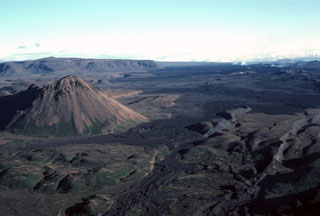Report on Krafla (Iceland) — October 1977
Natural Science Event Bulletin, vol. 2, no. 10 (October 1977)
Managing Editor: David Squires.
Krafla (Iceland) Inflation resumes
Please cite this report as:
Global Volcanism Program, 1977. Report on Krafla (Iceland) (Squires, D., ed.). Natural Science Event Bulletin, 2:10. Smithsonian Institution. https://doi.org/10.5479/si.GVP.NSEB197710-373080
Krafla
Iceland
65.715°N, 16.728°W; summit elev. 800 m
All times are local (unless otherwise noted)
After the eruption and deflation of 8 September, inflation of Krafla caldera resumed, and has continued at the pre-8 September rate. Dry tilt measurements indicated a complicated pattern of deformation. Repeated levelling showed that the caldera bottom had reached the pre-8 September elevation by mid-October.
During the 8 September event, magma was injected less than 1,200 m beneath the thermal areas, as shown by one drill hole that ejected tephra for half an hour. Since then, thermal activity at Námafjall has increased conspicuously, making access to the area difficult. This fall farmers in the area literally harvested boiled potatoes!
Remeasuring of geodimeter lines in late October indicated continued rifting of the fissure system, amounting to 20 cm since 15 September. Seismic activity is presently at a minimum, as was the case before the 8 September event. Renewed volcanic activity is expected before the end of November.
Geological Summary. The Krafla volcanic system in the Northern Volcanic Zone (NVZ) of Iceland is about 100 km long, consisting of a fissure swarm and a central volcano with a 7 x 9 km caldera formed about 110,000 years ago that deposited a rhyolitic welded tuff. It has been moderately active in the Holocene, over three distinct eruptive periods; the current one has lasted about 2,800 years with six volcano-tectonic episodes, each with one or more basaltic fissure eruptions. Lava volumes (DRE) have been in the 0.1-1 km3 range. The Hverfjall and Ludent tuff rings east of Myvatn were erupted along the fissure system. Myvatn lake formed during the eruption of the older Laxarhraun lava flow from the Ketildyngja shield volcano of the Fremrinamur volcanic system about 3,800 years before present (BP); The present Myvatn lake is constrained by the roughly 2,000 years BP younger Laxarhraun lava flow from the Krafla volcanic system. The abundant pseudocraters that form a prominent part of the Myvatn landscape were created when the younger Laxarhraun lava flow entered the lake. The last eruption took place in 1975-1984 CE when nine small basaltic fissure eruptions produced 0.25 km3 of lava.
Information Contacts: G. Sigvaldason, NVI.

